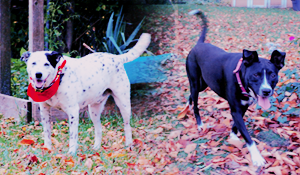It will take time to heal. If you truly love dogs you will find a way to heal.
It has been almost 10 years since i got attacked by a 160lb trained fighting dog. I still sometimes have flashbacks.
The odd thing is after the attack it was my favorite breed that i became most fearful of. The German Shepherd. (The dog that attacked me was supposedly Rott/Irish Setter, but looked 100% Yellow Lab.) (Try and figure out the psychology behind my brain's reasoning on that one.  )
)
I never had an ounce of fear in me before i got attacked. I didn't even fear the aggressive strays that were around. Respect for what they could do with their teeth yes; but fear, no. Now I can honestly say that i do fear dogs from time to time and even have a few panic attacks.
That is all pretty much behind me now though except for the rare occasional relapse. Those are usually over with in a few minutes.
What did I do?
Well, for I think the first few months i just let my emotions do whatever they were going to do. Besides dogs that i Knew VERY well I pretty much stayed away from other dogs. Then when i wasn't going being paralyzed any more by the mere sight of a dog I started to force myself to go up to every person/dog that i seen. Asking permission of I could pet their dog. I started going places where i know other dogs would be. When i started to be a bit more confident I joined a socialization class for dogs and even eventually went through the pound.
You know yourself best. Set the pace, but definitely work at it.
I don't suggest going to the dog park as soon as your dog recovers... that could be too much too soon. Try heading to a huge pet store first and see how both of you react.
G'luck. *HUGS*
~~~~
Glad to hear that something good came out of this tragedy.
~~~~
*edit note: Rotties are still one of my favorite breeds and i don't hold it against them for what one idiot did with his dog. (Mind you this dog left the guy's children with many wounds... He valued money more.)

Originally Posted by
luckypenny
Sorry if I stirred things up, but I was rather emotional yesterday. One of the people that responded was correct, I did happen across the old post and registered as a means to help deal with my pain.
I have a follow up. The Animal Control Officers were the ones that told me the dog was a Pit Bull. The dog in question was most likely bred to be aggressive. They were able to catch the dog as it came back while they were there photograghing the scene and my dogs injuries. Also several of my neighbors also came to my aid during and after the attack. Nice to know that I have such a great neighborhood. Using hoses we chased the dog off.
The Emergency Vet told me that when Animal Control Officers contacted the owner, and there was a nasty confrontation. The Animal Control Officers had to call the Police, as they were in fear of their safety.
They found a breeding situation and confiscated all of their dogs. There is a DOG GOD. I will not seek damages, as I feel justice has been done. I hope that the puppies find good homes. Our county has a strict policy regarding aggressive dogs, therefore this dog has a sad future.
My dog is recovering slowly, is on a high dosage of antibiotics and will recover. Thank God.
What can be done about the aggressive breeding of these animals? I know that it is not all dogs. I know that all dogs can bite, this was so much more than that. Thank goodness it was not a toddler, or me.
Of course I am traumatized. I love all animals, but this as really left an impact on me. To have my dog mauled, as this animal charged us from behind, is a nightmare that I cannot shake.
The Vet has urged me to take my senior back to the dog park when her injuries heal. It is something that we both used to enjoy so much.
Now it frightens me. I am so saddened by what is happening in our society.
I wish that we could control this in our cities, but I don't know how without restricting great dog owners to truly care and love their dogs.
Anyway, I am still really having a hard time dealing with this, but will not seek anything for my damages, as I hope that justice has been served.
I hope that no one else ever has this experience. I really mean that, and it makes me sad to think that someone thought that I wrote this only to "stir things up".
Sorry if that is what has occurred, but perhaps it will bring more awareness to a growing problem in out society.
Thank you all for listening and helping me heal.
.
Let nature guide your actions and you will never have to worry if you did the right thing. ~ crow_noir
The pet world excels where the human world is lacking; sterilization and adoption. ~ crow_noir
Please, if your dog is arthritic look into getting it Elk Velvet Antler. Look up my posts on it, PM me, or look it up on a search engine; but please if you love your dog and want it to live many more years consider this option. I've seen so many posts on here about dogs needlessly suffering. I can't make a new post about EVA every time so this plea is going here. EVA also helps with other ailments such as anemia.
Originally Posted by Marigold2






 Reply With Quote
Reply With Quote







 )
)


Bookmarks